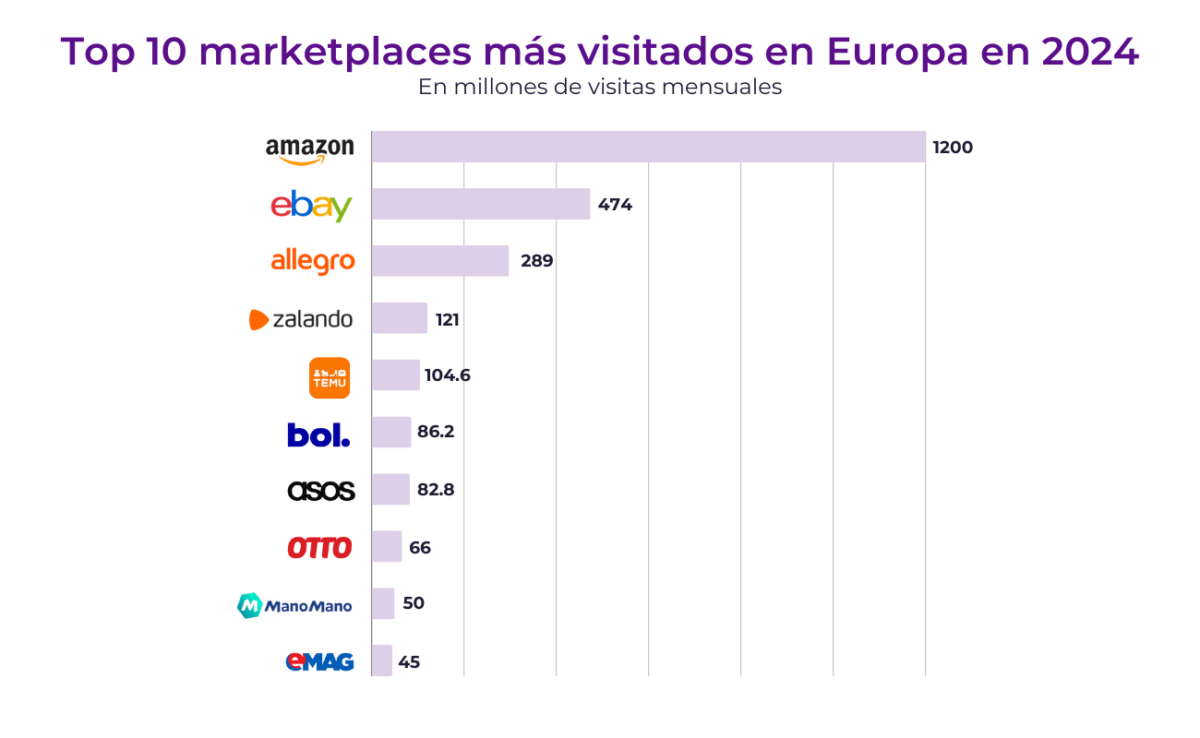5 issues that marketplaces cause in distribution for brands
In today’s digital era, marketplaces have become a fundamental channel for product distribution. E-commerce giants like Amazon, eBay, and Alibaba offer brands the opportunity to reach a global audience with established infrastructure. However, this advantage comes at a price: lack of visibility over online distributors. Supply chain transparency and distributor visibility are essential to maintain brand control, ensure service quality, and protect company reputation.

Source: The top 14 European marketplaces in 2024
Lack of visibility over online distributors can lead to numerous issues. Due to the enormous volume of sellers, brands often do not know who is selling their products or at what price, which can lead to margin erosion and brand dilution. Furthermore, this lack of control can result in an inconsistent consumer experience, negatively impacting brand perception and long-term value. As marketplaces continue to gain ground, it is crucial for brands to understand and address these challenges.
Distribution on marketplaces
Distribution through marketplaces offers many advantages, such as easy access to international markets and reduced operating costs. However, it also presents significant challenges. Marketplaces operate under a model that may limit brands’ control over their products, prices, and customer experience. Below, we explore 5 main issues causing distribution challenges for brands.
Main issues caused by marketplaces in distribution
Increased competition and consumer demands
One of the biggest challenges brands face on marketplaces is increased competition. On these platforms, products from different brands are directly compared, intensifying competition and raising consumer expectations. Buyers can easily compare prices, read reviews, and make informed purchasing decisions. This not only reduces profit margins for brands but also requires them to maintain exceptionally high quality and service standards to remain competitive.
Furthermore, consumers on marketplaces expect fast delivery, low prices, and excellent customer service. To meet these expectations, brands often have to invest significantly in logistics and support, further reducing their profit margins.
Omnichannel sales
Omnichannel sales are another significant challenge for brands. Today’s consumers use multiple channels to research and purchase products, including physical stores, brand websites, and marketplaces. Integrating these channels can be complex and costly. Brands must ensure that their marketing, inventory, and pricing strategies are consistent across all channels to provide a seamless shopping experience.
Without proper omnichannel management, brands may face issues such as channel competition, inconsistency in the customer experience, and difficulty tracking the performance of each channel. This can lead to a loss of control over distribution and ultimately negatively affect the brand’s reputation.
Globalisation
The globalisation of e-commerce has opened up many new opportunities for brands but has also introduced additional challenges. Selling in international markets requires a deep understanding of cultural differences, local regulations, and consumer preferences. Brands must tailor their marketing and distribution strategies to meet the specific demands of each market.
Additionally, international logistics can be complex and costly. Brands will need to manage shipping, import duties, taxes, and return policies in different countries. Without a well-planned internationalisation strategy, brands may face issues such as shipping delays, unexpected costs, and dissatisfied customers.
Potential margin and profitability loss
The relationship between sellers and marketplaces can be divided into two main models: 1P (First-Party) and 3P (Third-Party). In the 1P model, the brand sells directly to the marketplace, which then resells the products to the end consumer. In the 3P model, the brand uses the marketplace as a platform to sell directly to consumers.
Each model has its advantages and disadvantages, but both can negatively impact brands’ profit margins. In the 1P model, brands often have to accept lower prices and less favourable terms, as marketplaces control the final selling price. In the 3P model, although brands have more control over prices, they also face higher marketing and logistics costs. Both situations can result in reduced profitability.
Brand dilution
Finally, brand dilution is a critical issue on marketplaces. When a brand’s products are sold alongside numerous competitors, it can be difficult to maintain a strong and differentiated brand identity. Consumers may perceive the products as lower quality than they actually are, reducing brand loyalty and increasing price sensitivity.
In addition, the presence of unauthorised resellers can negatively affect the perception of product quality and authenticity. Marketplaces often have limited control policies on who can sell what products, leading to the emergence of grey markets or lower-quality products..

How can we solve these problems?
Despite the challenges, there are several strategies that can be implemented to mitigate the issues caused by marketplaces and improve distribution.
Improving distribution processes and enhancing the customer experience
One way to tackle these challenges is by optimising distribution processes and focusing on the customer experience. This will include implementing advanced management systems that allow brands to respond quickly to market demand and keep costs under control. It will also have to take into account the experience that we want to offer to the customer and ensure that their expectations are largely met.
Investing in technology and customer experience can improve efficiency, reduce delivery times, and increase customer satisfaction.
Implementing a monitoring system for all channels
To maintain control over distribution and the customer experience, brands must implement monitoring systems that cover all sales channels. These tools allow tracking the performance of each channel, identifying problems quickly, and making informed data-driven decisions. Comprehensive monitoring helps ensure that pricing, inventory, and marketing strategies are consistent across all points of sale.
Researching new countries where your products are sold
When expanding into international markets, it is crucial to research local regulations, import duties, cultural preferences, and consumer expectations. Adapting products and marketing strategies to each specific market can significantly improve the brand’s success abroad. A deep understanding of these factors can prevent costly mistakes and, again, exponentially grow customer satisfaction.
Having arguments to negotiate better and using a hybrid seller/vendor model
To protect profit margins, brands must develop a strong argument to negotiate better terms with marketplaces. This may include data on sales performance, customer loyalty, and brand value. Additionally, considering a hybrid seller/vendor model can offer greater flexibility and control. This approach allows brands to benefit from the advantages of both models, adjusting according to market conditions and specific needs.
Work on brand identity
Maintaining a strong and consistent brand identity is essential on marketplaces. Brands should invest in branding strategies that highlight their values and unique differentiators. This may include specific marketing campaigns and the creation of high-quality content, ensuring that marketplaces comply with all guidelines specified as important when selling the product. With a brand compliance and content monitoring tool, you’ll have this under control.
On the other hand, you can also use retail media to increase advertising revenue and optimise brand visibility. By strengthening the brand identity, companies can increase customer loyalty and reduce price sensitivity.
Optimising the potential of marketplaces and using analytics tools to overcome these challenges
Marketplaces have transformed the distribution landscape, offering significant opportunities for brands, but also presenting significant challenges. Lack of visibility over distributors, omnichannel sales, or potential margin loss are issues that cannot be ignored.
However, with the right strategies, these challenges can be managed, and the benefits of marketplaces maximised.
For brands seeking to maintain control and profitability in an increasingly complex sales environment, a monitoring tool for distributors, marketplaces, and sellers like flipflow is indispensable. This market analytics platform will not only provide visibility and control over your brand but can also offer valuable data for making informed, strategic, real-time decisions.
Ultimately, adopting an intelligence solution like this can help your brand successfully navigate the dynamic world of marketplaces.



